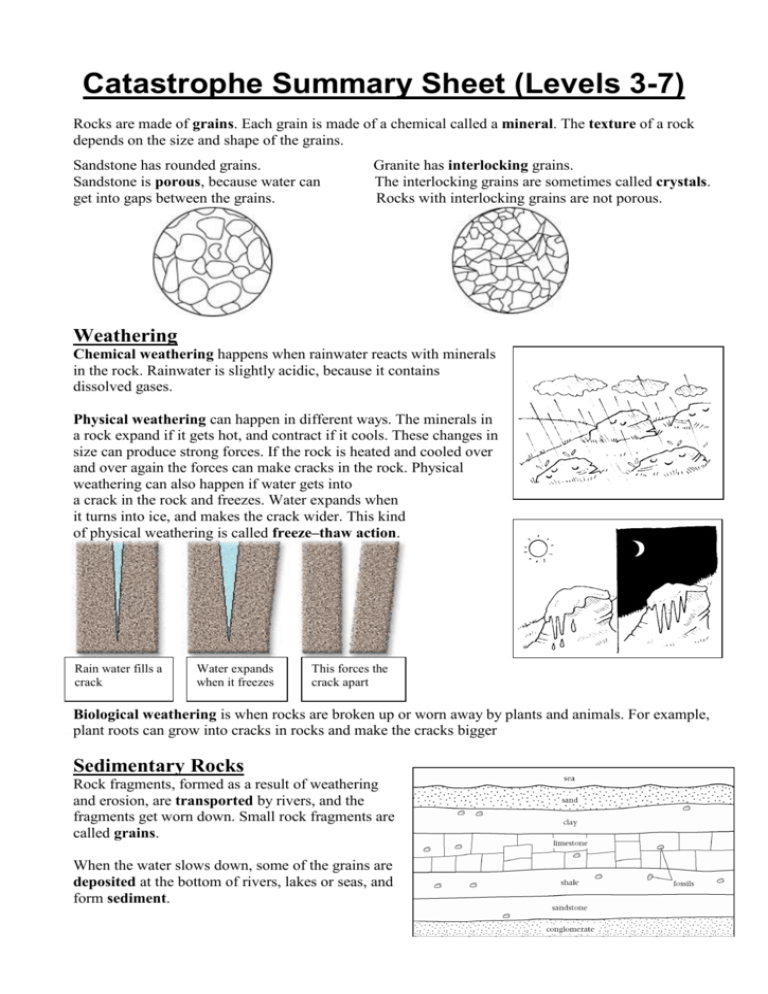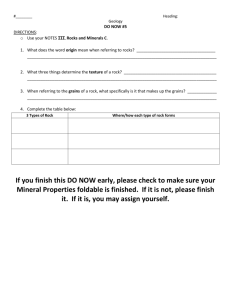Catastrophe Summary Sheet (Levels 3-7)
advertisement

Catastrophe Summary Sheet (Levels 3-7) Rocks are made of grains. Each grain is made of a chemical called a mineral. The texture of a rock depends on the size and shape of the grains. Sandstone has rounded grains. Sandstone is porous, because water can get into gaps between the grains. Granite has interlocking grains. The interlocking grains are sometimes called crystals. Rocks with interlocking grains are not porous. Weathering Chemical weathering happens when rainwater reacts with minerals in the rock. Rainwater is slightly acidic, because it contains dissolved gases. Physical weathering can happen in different ways. The minerals in a rock expand if it gets hot, and contract if it cools. These changes in size can produce strong forces. If the rock is heated and cooled over and over again the forces can make cracks in the rock. Physical weathering can also happen if water gets into a crack in the rock and freezes. Water expands when it turns into ice, and makes the crack wider. This kind of physical weathering is called freeze–thaw action. Rain water fills a crack Water expands when it freezes This forces the crack apart Biological weathering is when rocks are broken up or worn away by plants and animals. For example, plant roots can grow into cracks in rocks and make the cracks bigger Sedimentary Rocks Rock fragments, formed as a result of weathering and erosion, are transported by rivers, and the fragments get worn down. Small rock fragments are called grains. When the water slows down, some of the grains are deposited at the bottom of rivers, lakes or seas, and form sediment. Layers of sediment collect on the sea bed, and the bottom layers get squashed. The grains of sediment are forced closer together (compacted) and the water is squeezed out from between the grains. Minerals in the sediment ‘glue’ the grains of rock together (cementation). Eventually, sedimentary rock is formed. If any animals or plants get trapped in the sediment, they may form fossils. Sandstone Limestone Igneous Rocks Molten rock is called magma. If the molten rock flows out of volcanoes it is called lava. Igneous rocks are formed when magma or lava cools down. Sometimes lava cools down quite quickly, and forms igneous rocks with small crystals (Basalt). Magma underground cools down much more slowly, and forms rocks (Granite), with bigger crystals. Granite Basalt Metamorphic Rocks Sedimentary or igneous rocks can be changed by heat or pressure into new kinds of rock, called metamorphic rocks. They have different properties from the rocks they were made from. Slate Type of rock Examples Marble igneous metamorphic basalt, granite, pumice marble, slate, gneiss Grains or crystals? Hard or soft? Porous? sedimentary limestone, sandstone, mudstone, chalk grains in layers soft or crumbly yes crystals quite hard no crystals in bands very hard no Fossils? yes no sometimes The Rock Cycle The Earth is continually changing. Rocks are weathered and eroded and new rocks are being formed. The processes which make rocks, weather them and change them are linked together in the rock cycle. Collaboration Scientists don’t usually work alone. They often work in teams and collaborate together. This means that individual scientists bring different knowledge and skills to the team e.g. seismologists, dome growth specialists etc. Collaboration means you are less likely to get mistakes and it makes conclusions more valid. Scientists from all over the world sometimes collaborate together, sometimes via the internet, e.g. the IMVRT team (International Mobile Volcano Response Team). The Earth The Earth is made up of 4 main layers. The crust is the thinnest. The mantle is a thick layer of solid rock which gets hot enough in places to melt into magma (molten rock). The core is heated up by radioactive materials breaking down. The inner core is the hottest part of the earth. mantle






